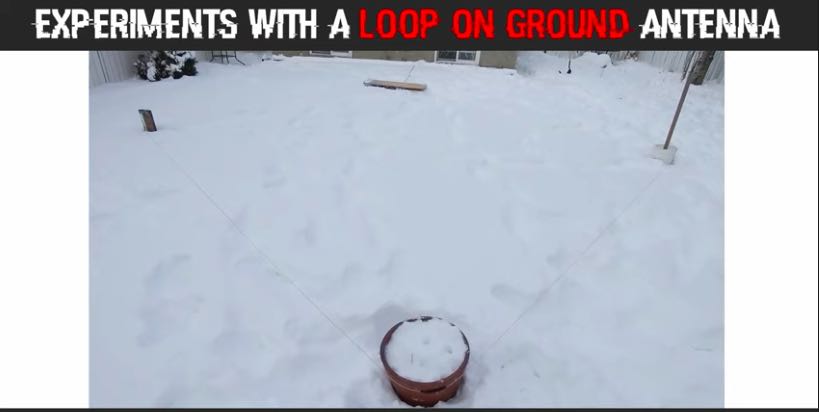 Many thanks to SWLing Post contributor Rob, with Frugal Radio, who writes:
Many thanks to SWLing Post contributor Rob, with Frugal Radio, who writes:
On New Year’s Day I decided to spend some time make a Loop on the Ground HF antenna. It had been a project I had wanted to undertake for a while, after seeing the KK5JY web site.
The LoG is supposed to work fairly well in noisy RF environments, and with my house being in suburbia,I thought it would be worth a shot.
I use some old speaker wire, RG6, some connectors I had lying around, and some random items from the back yard (old tyre, flower pot etc). It only took about 30 minutes to build with the stuff I already had lying around. I used a NooElec balun as my transformer.
Despite the snow on the ground, it all worked.
I made a video showing the construction and initial testing which your readers may enjoy.
As you mention, Rob, the LoG has become a very popular antenna for folks living in an urban RFI jungle. Paired with a nice high dynamic range SDR, the results are quite impressive and the noise floor much lower than it would be with a traditional wire antenna or even a sky loop. I am curious how it compares with any other antennas as your home. Thanks for sharing!

A simple but effective receive antenna that has a small foot print.
I made a portable version for experiments out-in-the-field with some tent pegs and thick speaker wire.
I use a switch box to allow a separate receiver antenna or the receive antenna jack on the back of the Icom
The noise floor and static crashes are reduced and even with less signal voltage available the read ability is improved.
Seems to work on snow, under snow and when its sunny.
John ve3ips
There is a very extensive discussion on this topic on the RadioReference website
https://forums.radioreference.com/threads/160-20m-log-loop-on-ground.370110/
And now even a FB group for it
https://www.facebook.com/groups/319198328872015/
Hi Mike, yes I know about that discussion, but while interesting, they made a number of mistakes (at least in own experience); the loop wire MUST be on the ground, NOT raised; the transformer MUST be of the same (galvanic isolation) design and using a proper core material; the loop diameter should either be kept as the original one or, willing to favor lower frequencies, increased BUT keeping in mind what reported on KK5JY site; the antenna should be placed on a spot w/o underlying/nearby metal objects; the stakes used to keep the antenna wire in place MUST be NON conductive (i.e. no metal)
and some personal suggestions
add some snap-on chokes to the coax, right after the transformer; use cheap “RG6” (double shield) to feed the antenna; ground the coax braid at the opposite end from the antenna
HTH
Hi –
Has anyone tested/tried burying the LOG down a few inches (so it can stay in the yard/garden without picking it up to mow the grass etc.) ?
That would be a perfect solution for my environment, then it is very low maintenance.
My thoughts are them I could use/tune my magloop for TX and use the LOG for broadband RX, best of both antenna types.
Please let me know your thoughts or experiences.
John – W3JED
forgot, if/when possible, lay the antenna ON ground (not above it); I understand the situation (snow…) but consider that the LoG will work fine even under the snow
If one lives in an urban (noisy) place or in a spot which, over the year, is subject to thunderstorms and/or “static precipitation”, then the LoG is defnitely a SOLUTION, and while I could testify that in person, KK5JY is the one which designed such an antenna since, otherwise, he was “off the air” due to noise
Now, the above brings us to a reasoning, that is, sometes we tend to use the same antenna for both tx and rx. but… why ? I mean, the purpose of a tx antenna and the one for an rx one are different, so… why not using the LoG as an rx only antenna, coupling it with a tx one ? All in all it will just mean adding a PTT controlled relay !
All i can say is that a (proper) random wire for tx, coupled to a LoG for rx could result in a surprising combo and is affordable even to a poor ham, so, why not ?
Just go with LoG for RX and hang another loop for TX top of it, about 1/4 to 1/2 wavelenghts is ok.
If You want more, use one relay to ground whole RX loop to an same ground as TX chassis when transmitting.
If You have time, some more parts and know what You are doing, go for an phasing, and You should have an moster NVIS antenna.
If You have an big property, lay four of these gems, and make phased array from them.
Easiest way is to start test with simple upper-HF Deltaloop, on a fishing pole, top of an LoG. This wont allow phasing, but has an nice extra gound, as loop is good as ground under it.
My old 160m loop on a swamp with an 60m RG213 cable outperformed my new loop on new QTH.
New QTH is on an hill, about 185M ASL, but I have to get grounding done, new loop is deaf as rock, and I have 3-5 S-units lower signal.
Phased loops are on edge of magic….
placing a tx antenna near or on top of a LoG isn’t a good idea, not only it will alter the LoG pattern, but if you. try connecting a lamp to the LoG feedline end, you’ll see it lighting up while transmitting with the nearby antenna